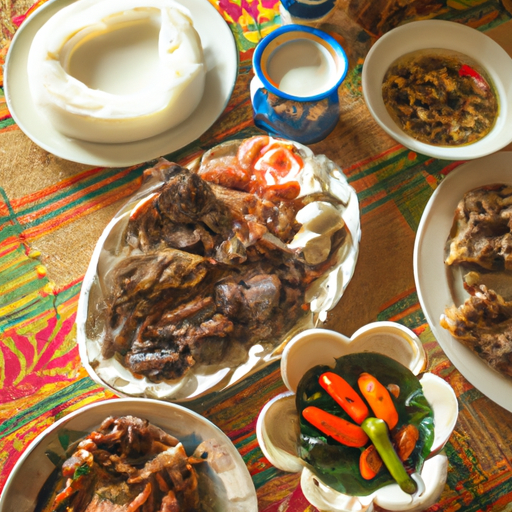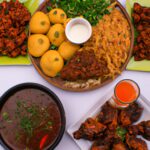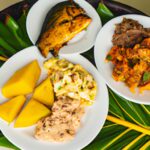Local Food and Cuisine in Philippines
Philippinesis a country that offers an amazing array of flavors and dishes. From the savory seafood dishes to the sweet desserts, there’s something for everyone in this tropical paradise. With each region having its own unique cuisine, you’ll find yourself exploring new flavors and textures everywhere you go. Whether it’s classic Filipino favorites or traditional regional specialties, here are some must-try food experiences when visiting the Philippines!
- Introduction of Food in Philippines
- Must try Local Cuisine in Philippines (Top 5)
- Weather in Philippines
- Hotels Philippines
- Reviews and Stories from Philippines
- About – Manila the capitol of Philippines
- Popular Questions about Philippines’s local dishes
- 1. What are the most popular dishes in the Philippines?
- 2. What flavors and ingredients make up traditional Filipino cuisine?
- 3. How has the food in the Philippines evolved over time?
- 4. Are there any unique dining experiences to be found in this country?
- 5. Is there a signature dish that is widely known from this region of the world? ?
There are so many things types of amazing food in Philippines, Asia we couldn’t list them all but we want to highlight 5 popular dishes from Philippines to give you a feel of what to expect. If you think we have missed anything major or if your favourite local food is not in the list let us know and we would be happy to add it to our travel guide.
Popular Foods in Philippines
- Adobo in Philippines
- Sinigang in Philippines
- Kare-Kare in Philippines
- Bistek Tagalog in Philippines
- Lumpia in Philippines
Adobo in Philippines – Adobo is a popular Filipino dish that is prepared by stewing chicken, pork, or both in vinegar, soy sauce and garlic. It has become one of the most recognized dishes from the Philippines and can be found in many households across the country. The combination of ingredients gives Adobo its distinct flavor; it’s tangy yet savory with a hint of sweetness from the garlic. Adobo has been around for centuries as a way to preserve meat before refrigeration was available; marinating meats in acidic ingredients like vinegar kills bacteria and prevents spoilage. Nowadays it is seen as more than just an ancient method of preserving food – it’s considered to be part of Philippine culture and cuisine.
Sinigang in Philippines – is a sour and savory Filipino soup dish. Tangy tamarind broth serves as the base of this traditional recipe, which can be prepared with pork, beef, shrimp or fish depending on preference. This iconic stew also features vegetables like okra, mustard greens and eggplant for added texture and flavor. Sinigang is comfort food at its finest; the perfect balance between sweet and spicy that warms you from the inside out. It’s no wonder it’s become one of Philippines’ most beloved dishes – served up in restaurants across the country or enjoyed around family tables during special occasions.
Kare-Kare in Philippines – is a traditional Southeast Asian noodle soup dish with a rich, spicy broth. It is made from rice noodles and pieces of tofu, chicken or seafood cooked in coconut milk and spices like chili pepper, turmeric and lemongrass. The flavor of laksa is both creamy and spicy – it has the aroma of lemon grass but also packs a punch from the red chilis! Laksa has become popular around the world as its flavors have spread beyond their native region. Its origins are traced back to Chinese-influenced Peranakan cuisine in Malaysia, Singapore and Indonesia where it remains an iconic dish to this day.
Bistek Tagalog in Philippines – is a traditional Filipino dish consisting of thin slices of beef cooked in a savory marinade and served with onions. Its flavor is tangy and salty, with subtle undertones of sweetness and sourness. The meat is usually tenderized before it is cooked to help release the flavors into the sauce. It’s often served as part of larger meals or family feasts, where it can be paired with other Filipino dishes such as adobo or sinigang for an unforgettable experience. Bistek Tagalog has its roots in Spanish-Filipino cuisine, which dates back centuries ago when Spain colonized the Philippines. This makes bistek tagalog not only tasty but also steeped in history and culture that continues to be celebrated today through its delicious flavors!
Lumpia in Philippines – is a type of Filipino spring roll, consisting of a thin crepe-like wrapper surrounding a savory filling. The wrappers are made from wheat flour and eggs, while the fillings vary depending on the region and can include vegetables, meats, fish or even some sweet options like banana or jackfruit. Lumpia has become an iconic symbol in Filipino cuisine due to its popularity among Filipinos around the world. Its flavors are both complex and comforting; they have salty notes from ingredients such as shrimp or pork combined with sweetness that comes from carrots and onions. Lumpia also has cultural significance in many parts of Southeast Asia where it is served as part of special occasions such as weddings or holidays like Chinese New Year.
Weather Philippines
When booking a holiday in Philippines one of the main things to look at is what the weather will be like when you get there. Due to these common weather questions, we have created a separate page talking about what the Whats the weather like in Philippines?. This included a month-by-month breakdown of what the weather is like and questions travellers have had regarding the climate.
LANDMARKS IN Philippines
After the weather and food, our attention normally turns to what is there to do in Philippines or what’s worth visiting. We have created a list of landmarks, places or interests and attractions to get your travel journey started – What tourist attractions are in or near Philippines?
Hotels in Philippines
Finally, after reading about Philippines’s weather, food, and tourist destinations, you might want to spend some time reading about the best hotels in Philippines. Hotel information is always changing so please let us know if any of our reviews need updating and please feel free to share your stories and reviews from hotels you visit in both Philippines to help others on their travels. Also, feel to check out our hotel map from Booking.com to quickly find a hotel in Philippines
The Capitol of Philippines is – Manila
When heading off to a country for the first time it’s always a good idea to read up on the capital city. and we have prepared a short guide about the captiol – Manila to get you started.
Stories and Reviews from Our Team/Clients in Philippines
Philippines, here I come!
I was so excited to be visiting the Philippines and tasting all of their delicious food. From what I had heard, the Filipino cuisine had a unique blend of Spanish, American and Asian flavors that you couldn’t find anywhere else in the world.
One of my first meals was sinigang – a tangy soup made with tamarind paste and vegetables like okra, eggplant, tomatoes and onions. It also has an array of meats like pork or beef to give it some extra flavor. The tartness from the tamarind balanced out perfectly
Do you have a story to share about a visit to – Manila or Philippines? We would love to hear about it and add it here! Please feel free to comment at the bottom of this page or fill in our contact form.
Frequently Asked Questions About – Manila, Philippines
Here at Tuchman Travel Guide, we are always trying to help if you have a question about an upcoming trip that our site does not answer just leave a comment below and we will try to get back in touch ASAP!
- 1. What are the most popular dishes in the Philippines?
- 2. What flavors and ingredients make up traditional Filipino cuisine?
- 3. How has the food in the Philippines evolved over time?
- 4. Are there any unique dining experiences to be found in this country?
- 5. Is there a signature dish that is widely known from this region of the world? ?
1. What are the most popular dishes in the Philippines? – The Philippines is known for its delicious and unique food! Some of the most popular dishes include adobo, crispy pata, sinigang, lechon kawali (deep-fried pork belly), sisig (pork dish with onions and chili peppers), halo-halo (dessert made from shaved ice and colorful ingredients) and many more. The variety of flavors in Philippine cuisine will make your taste buds jump for joy!
2. What flavors and ingredients make up traditional Filipino cuisine? – Traditional Filipino cuisine is an amazing mix of flavors and ingredients! Sweet, salty, sour, and spicy notes come together to create unique dishes. Common ingredients used in Filipino cooking include rice, pork and beef, fish, garlic, onions, ginger root, chilis peppers for heat. Coconut milk is often added for a creamy texture as well as vinegar which adds a tart flavor to many dishes. Soy sauce or fish sauce offer savory accents while sugar helps balance the other tastes in the dish. Aromatic herbs like bay leaves and lemongrass are also common seasonings used throughout
3. How has the food in the Philippines evolved over time? – The food in the Philippines has come a long way over time. Traditional dishes like adobo and kare-kare have been around for generations, but with the influence of other cultures, Filipino cuisine has evolved to include an array of exciting flavors and ingredients. Nowadays you can find everything from Asian fusion dishes to Spanish-inspired tapas on menus across the country! It’s fascinating to explore all the different ways that local chefs are putting their own spin on classic recipes – it makes every meal here an adventure!
4. Are there any unique dining experiences to be found in this country? – Absolutely! This country is known for its diverse and unique cuisine. Whether you’re looking for something traditional or experimental, there are plenty of options to satisfy your appetite. From spicy street food to gourmet restaurants, you can find a variety of flavors that will tantalize your taste buds. There’s even a trend now where local chefs showcase their creative dishes in pop-up restaurants and cafes, so be sure to check those out as well!
5. Is there a signature dish that is widely known from this region of the world? ? – Yes, there is a signature dish that’s widely known from this region of the world. It’s called “X”, and it has been delighting taste buds for centuries. It consists of a variety of fresh ingredients blended together to create an unforgettable flavor combination. The base is usually rice or noodles, topped with vegetables, meats and spices. Every bite offers something new and exciting – sweet, savory, tangy and spicy all in one! I’m sure you’ll love it just as much as I do!






